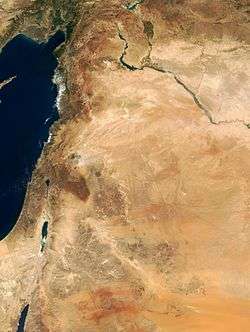1202 Syria earthquake
 | |
| Date | 20 May 1202 |
|---|---|
| Magnitude | 7.6 Ms |
| Epicenter | 33°30′N 36°00′E / 33.5°N 36.0°ECoordinates: 33°30′N 36°00′E / 33.5°N 36.0°E |
| Areas affected |
Ayyubid Sultanate Kingdom of Jerusalem |
| Max. intensity | XI (Extreme) |
| Tsunami | Yes |
| Casualties | 30,000–1,100,000 |
The 1202 Syria earthquake struck at about dawn on 20 May 1202 (598 AH) with an epicenter in southwestern Syria. Up to 1,100,000 deaths have been associated with this earthquake, although other estimates are much smaller. It was felt over a very wide area, from Sicily to Mesopotamia and Anatolia to upper Egypt, mostly affecting the Ayyubid Sultanate and the Kingdom of Jerusalem. The cities of Tyre, Acre and Nablus were heavily damaged. A magnitude of Ms = 7.6 has been estimated with damage up to XI on the Mercalli intensity scale.
Records of the earthquake
A large earthquake or series of earthquakes is described in many written sources during the period 1201–1202 (597–598 AH). It is unclear as to whether they refer to a single mainshock with several large aftershocks or more than one unrelated earthquake. Given the rarity of such large events in this area it has been considered more likely that the reports all refer to the same mainshock.[1] Other workers have recognised two separate events, the earlier (Ms = 7.5) on 6 June 1201 and the latter (Ms = 6.8) on 20 May 1202, occurring on two different (but contiguous) segments of the Dead Sea Transform.[2]
Cause
The distribution of reported damage strongly suggests that the earthquake resulted from movement on a segment of the dominantly strike-slip Dead Sea transform.[3] Detailed studies of recent sediments along the line of the Yammoûneh Fault, which borders the Beqaa Valley, support movement on this fault as the most likely origin for the 1202 earthquake.[4] Field evidence for the 1202 earthquake rupture have been first reported by Marco et al. (1997) and Ellenblum et al. (1998) who discovered the displaced walls of the Vadum Iacob Crusader fortress (at Tell Ateret), as well as by Marco et a. (2005) and Wechsler et al. (2014) who found displaced stream channels in the Bet Saida Valley.
The tsunami reports associated with this earthquake are unlikely to be directly caused by the movement of the fault as none of the fault displacement happened beneath the sea. Most large tsunamis recorded in the eastern Mediterranean are thought to be the result of seismically triggered underwater landslides.[5]
Effects

Areas affected
The earthquake was felt from Sicily in the west to northwestern Iran in the east, and from Constantinople in the north to Aswan in the south. The affected areas - listed by decreasing order of the intensity - were, in today's terms, Lebanon, central Palestine, western Syria, Cyprus, northern Israel, Jerusalem, Jordan, southern Turkey (Antioch, Lesser Armenia, eastern Anatolia), Sicily, Iraq and Iran, Egypt (as far south as Aswan), Constantinople and Ceuta.[6]
The greatest damage was reported from Mount Lebanon, Tyre, Acre, Baalbek, Beit Jann, Al-Samyra, Nablus, Banyas, Damascus, Hauran, Tripoli and Hama (VIII-IX on the Mercalli intensity scale).[3][6]
Tsunami
Tsunami probably associated with this event were observed on eastern Cyprus and along the Syrian and Lebanese coasts.[6]
Casualties
The figure of 1,100,000 deaths often quoted for this earthquake includes all deaths for the year in question, including those from the famine and subsequent epidemics caused by the failure of the Nile flood that year.[6] A more realistic estimate has been made from the analysis of contemporary records of 30,000 deaths.[1]
See also
References
- 1 2 Paula Dunbar. "Information on the earthquake from the National Geophysical Data Center". Archived from the original on 29 April 2009. Retrieved 16 April 2009.
- ↑ "Khair, K., Karakaisis, G.F. & Papadimitriou, E.E.P. 2000. Seismic zonation of the Dead Sea Transform Fault area. Annali di Geofisica, 43, 61-79." (PDF). Archived (PDF) from the original on 29 April 2009. Retrieved 16 April 2009.
- 1 2 Ambraseys, N.N. and Melville, C.P. 1988. An analysis of the Eastern Mediterranean earthquake of 20 May 1202, in History of Seismography and Earthquakes of the World, edited by W.H. Lee (Academic, San Diego, CA), 181–200.
- ↑ "2005. Daëron, M., Klinger, Y., Tapponier, P., Elias, A., Jacques, E. & Sursock, A. Sources of the large A.D. 1202 and 1759 Near East earthquakes. Geology, 33, 529-532." (PDF). Archived (PDF) from the original on 29 April 2009. Retrieved 16 April 2009.
- ↑ Salamon, A., Rockwell, T., Ward, S.N., Guidoboni, E. & Comastri, A. 2007. Tsunami Hazard Evaluation of the Eastern Mediterranean: Historical Analysis and Selected Modeling. Bulletin of the Seismological Society of America, 97, 705–724.
- 1 2 3 4 Mohamed Reda Sbeinati; Ryad Darawcheh; Mikhail Mouty (2005). "The historical earthquakes of Syria: an analysis of large and moderate earthquakes from 1365 B.C. to 1900 A.D.". Annals of Geophysics, Vol. 48, N. 3, June 2005. pp. 381, 389–391, 410. Archived from the original on 9 April 2015. Retrieved 3 April 2015.